Your real estate investor business needs consistent leads. Getting your website to rank on the first page of Google is the best way to ensure you are able to close 3-5 deals a month. In order to rank your website, you need to learn about on-page SEO for real estate investors. In this blog post, I am going to do my best at teaching you EVERYTHING I know about on-page SEO and how to optimize real estate content so you can easily rank in Google search.
Table Of Contents
- Finding Keywords
- Page Title Tag
- Make Your URL SEO Friendly
- Optimize Your H1 Tag
- Optimize Your Images
- Add Your Keyword In The First 100-200 Words
- Mobile Friendly Websites
- Outbound Linking Strategy
- Internal Linking Strategy
- Have A High Performing Website
- Sprinkle In LSI Keywords
- Create Valuable Content
1. Pick The Keyword You Want To Rank For
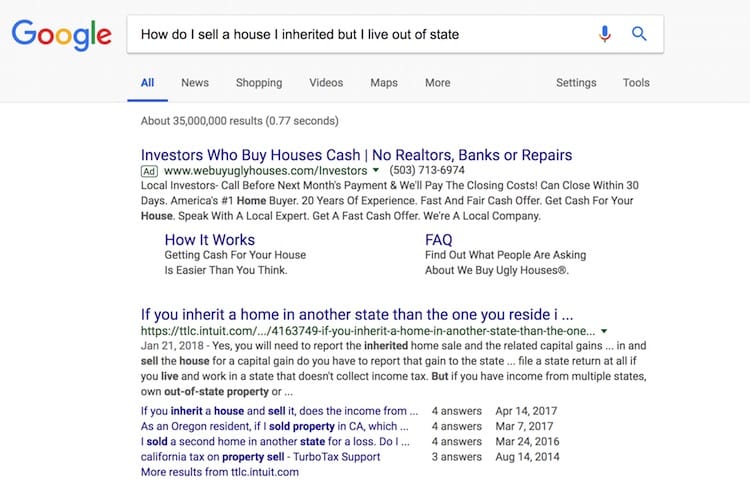
This probably seems obvious but before you start trying to optimize a page for a search term you need to actually pick the keyword. I will often time jump on coaching calls or talk with investors and ask which keywords they are targeting and they say one of three things
- I don’t know which keywords to target
- The usual, “we buy houses” etc.
- All of them
Answer #2 and #3 aren’t technically wrong but you must be focused with your on-page SEO in order for it to work. I have talked about this before but each page or post on your website should be targeting only 1 specific keyword. You can have modifier or LSI keywords in the content but the page itself should try and be ranked for a specific search term.
How do you find the right keyword to rank for?
That is a loaded question. You have to find the winning combination of
- Enough traffic to justify the work,
- Medium to low competition to justify the work
- Enough search intent to turn the click into a lead
For the purpose of this blog post let’s assume you have a targeted keyword like “Sell my house fast in Denver” as your selected phrase to rank for.
2. Start With The Page’s Title Tag
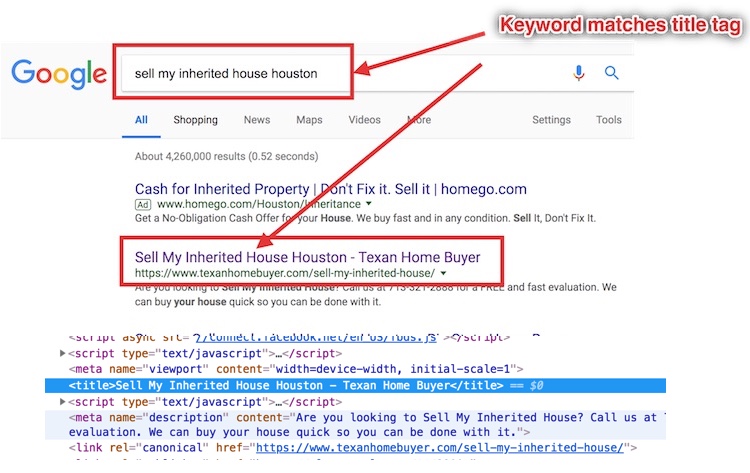
Remember back to when you use to write assignments in school. What was the first thing you would do before you start writing your assignment? You put the assignment title or heading on the paper so your teacher knew what it was about.
That is exactly how you should treat search engines with your real estate investing content.
The SEO Title Tag is one of the most important pieces of metadata on your page. Go here if you want to learn how to set up your page correctly so you can rank content on your Carrot site.
“Title tags are a major factor in helping search engines understand what your page is about.” – Moz.com
In the example above, I searched for a competitive keyword “sell my inherited house Houston“. I found the first organic search result (a Carrot website) and the title tag is the exact keyword I typed in.
Now, just because you have the same title tag as the top results in Google won’t mean you will out rank the competition. But you are starting behind the 8-ball if you aren’t optimizing for the keywords that bring traffic.
How to optimize your title tag
- Write a title tag less than 77 characters (Google ignores anything after this)
- Don’t stuff a bunch of keywords in your title tag
- Give every page a unique title tag
- Put the important keyword first
- Add your brand name on the end to rank for branded keywords
- Always write for your leads not search engines (don’t sound spammy)
The Big Takeaway: Each page should have a unique title tag that has your keyword and isn’t spammy.
3. Make The Page URL “SEO Friendly”
There is a ton of information about SEO for real estate on the internet. It can feel overwhelming at times. The URL you give your page DOES matter.
I don’t want to make this more complicated then it really is. If you want to learn more about the anatomy of a well-structured URL check this post out.
In short, your URL should try to include the keyword and be easy to read so the user knows what content is on the page they are about to click.
If you study a Carrot website you will see that each URL goes after a unique keyword and they are structured in a way to guide a potential lead down a journey of converting them.
There are common URL structures that your blog or website should follow. I will briefly outline them below.
- www.domainname.com/blog/the-title-of-the-post
- www.domainname.com/the-title-of-the-post/
- www.blog.domainname.com/the-title-of-the-post/
Here is a bad example of a URL
- www.domainname.com/blog/september/real-estate/houston12334234.html#?33id
This is bad because it takes a while for Google to figure out where the content is and what it is about and no one is going to remember that URL
Once you establish your structure you should keep it the same and start focusing on the content on each of these URLs.
The Biggest Takeaway: Make the URL short, to the point, and include the keyword.
4. Only Use One H1 Tag
Most real estate investor websites will allow you to edit the content on the website. When you are editing content you will be able to change the headings of your content.
Each page should only have one H1 tag.
The H1 tag is the most important heading on the page because it further qualifies what the content is all about. Your title tag and H1 tag should be very similar.
If you are using Carrot then you have a couple options for placing your H1 tag on your page.
- If you are writing a blog post the title of the blog is automatically converted into an H1 tag
- If you are creating a page you can place the H1 tag in the hero section of the page (see screenshot below).
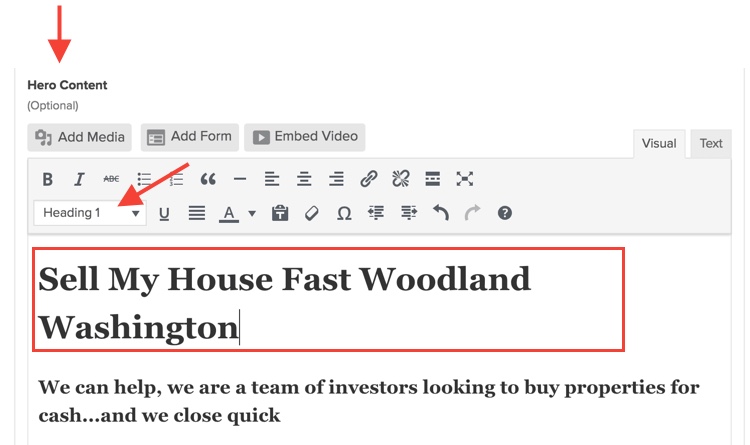
You might be thinking…when should I be using H2, H3, etc and do they carry any SEO weight?
From all the research and testing I have done the other headings are more for the end user and making it easy to read the sections of your text.
I generally use H2 for all of my secondary headings and include an LSI keyword.
I use H3 and H4 tags for purely stylistic reasons to call out content that I want to stand out when a reader is scrolling down the page.
The Big Takeaway: Only include one H1 tag on each page or blog post.
5. Include An Image Or Video
If you take a look at this blog I will always include an image within the first couple hundred words of text.
The reason I do this is 3-part.
- The image can engage the reader to read more of your content if it catches their eye
- You can use the alt text to place a keyword on the page
- A video or image can rank for a search term
One of the best blog posts I have ever seen that talks about how to use images in blog posts is from Neil Patel. Check out his 11 best practices for including images in your content.
I have tested hundreds of Carrot websites and I can tell you that stock images tend to perform worse than real images.
If you don’t have images of properties you are selling or have sold your next best option is to find royalty free images that don’t look so cheesy like stock photos.
Most end users can easily tell if a photo is phony and it actually hurts your credibility more than it helps.
The Big Takeaway: Use real images, break up the text, and optimize the image for search.
6. Add LSI Keywords
(Latent Semantic Indexing) LSI keywords aren’t as scary as they sound. They are simply related words that give Google and the lead more information about what is on the page.
For example “Sell my house fast Houston” is semantically related to “How do I sell my house fast in Houston?”
To Google, this shows the same intent based on the user’s query.
The best place to find LSI keywords it at the bottom of Google search term. Not only does this give you more keyword ideas but it tells you what Google thinks is related.
Use this information.
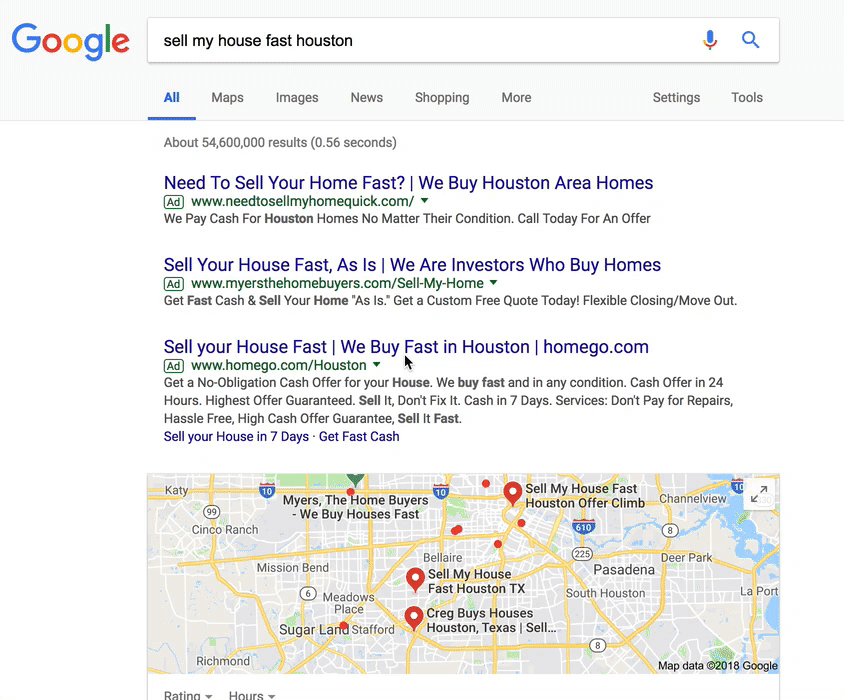
7. Use Your Keyword In The First 100-200 Words
There is research out there suggesting that having the keyword in the first part of the content is a ranking signal for Google.
It’s a simple, actionable step to make sure you include a little more context to your content. Try using an exact match keyword or an LSI keyword in here.
Another thing to consider about the first 100 words in your page or post is that is typically what is used when your link is shared on social media. Make the content relevant and encourage the reader to scroll down and keep engaging in your content.
8. Make Your Website Mobile Friendly
I could write an entire blog post about the importance of mobile-friendly websites.
But one thing I want to clear up right now is this
Mobile responsive means the website breaks down nicely on smaller screens.
Mobile FRIENDLY means the user experience is good on mobile devices (buttons are easy to click, phone numbers are easy to tap, etc.).
How do you know if your website is mobile friendly?
You can check a couple of places…
If you are a Carrot member you can rest assured that your websites are tested on mobile and nearly 60% of all Carrot leads come from mobile devices.
You can look in Google Analytics to see if your conversion rate or bounce rate differ from desktop and mobile.
Or you can use a service like Google’s Mobile-Friendly Test. I am a big fan of using Google’s tools to see what they think of the website versus another 3rd party test.
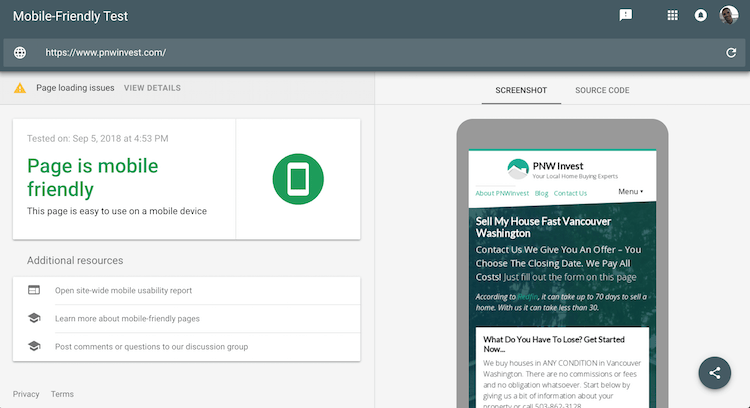
9. Make Sure Your Website Loads Fast
It’s important to take your mobile performance and experience one step further.
Websites must load fast.
Google released some data about mobile page load times.
The average time it takes to fully load the average mobile landing page is 22 seconds. However, research also indicates 53% of people will leave a mobile page if it takes longer than 3 seconds to load.
How does this affect your real estate investor website?
Check the speed of your website here.
If your page loads slower than 3 seconds you should send the results to your web developer and see if they can help you speed it up.

10. Only Link To Credible Websites
Links on your real estate investing website are like gold.
The links that point to your website are viewed in Google’s eye as a strong recommendation that your content is worth being shown to users.
With that in mind, make sure you only link out to credible sources.
What qualifies as a credible source? Websites like colleges, popular news sites, and Wikipedia would be considered credible.
If you aren’t sure you can always convert the link to a no-follow link which means the link juice is not passed along.
11. Link To Your Other Relevant Content
Nearly all real estate investors miss this step.
Google crawls your website.
It can literally see how every page is interconnected to each other like a spider web. The more links that go to a single page (like the Home Page) gives Google some ideas about the most important content on your website.
There is a secondary benefit to this linking strategy, users can easily navigate your content when you give them links to the next topic they have on their mind.
Long story short, just find creative ways to link to other HIGHLY relevant content. Don’t just link to link, give the reader some value.
Bonus Tip: When you launch a Carrot website this is already done for you. It literally saves you hours of linking because the pages and content are already built out and linked in a strategic way.
12. Add Value With Longer Content
According to Neil Patel, writing long 2,000 word posts is what it takes to rank in this day and age. Check out the data in his blog post for more information.
Real estate investors don’t necessarily need 2,000-word blog posts on everything but it might be worth a test. If you are struggling to rank for a keyword try increasing the length.
Remember this is an on-page SEO strategy. Likely backlinks can get you over the page 1 threshold but well written, long content does get shared more and seem to rank better.
Wrapping It Up
We have covered a ton of information in this post. Don’t worry if everything didn’t stick.
In order to help you with your real estate content strategy and ranking for keywords you want to rank for, I have put together a simple checklist you can download below.
Download The FREE Checklist Now!
Use this checklist whenever you are working on your website’s SEO.
If you need help with your website’s SEO drop me a comment a below and tell me what you need help with.